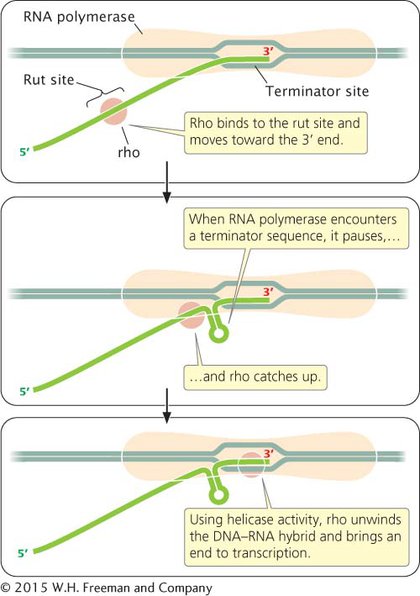Termination
RNA polymerase adds nucleotides to the 3′ end of the growing RNA molecule until it transcribes a terminator. Most terminators are found upstream of the site at which termination actually takes place. Transcription therefore does not suddenly stop when polymerase reaches a terminator, like a car stopping at a stop sign. Rather, transcription stops after the terminator has been transcribed, like a car that stops only after running over a speed bump. At the terminator, several overlapping events are needed to bring an end to transcription: RNA polymerase must stop synthesizing RNA, the RNA molecule must be released from RNA polymerase, the newly made RNA molecule must dissociate fully from the DNA, and RNA polymerase must detach from the DNA template.
Bacterial cells possess two major types of terminators. Rho-
RHO-

RHO-

The string of uracil nucleotides in the RNA molecule causes the RNA polymerase to pause, allowing time for the hairpin structure to form. Evidence suggests that the formation of the hairpin destabilizes the DNA–RNA pairing, causing the RNA molecule to separate from its DNA template and transcription to terminate.
POLYCISTRONIC RNA In bacteria, a group of genes is often transcribed into a single RNA molecule, which is termed polycistronic RNA. Thus, polycistronic RNA is produced when a single terminator is present at the end of a group of several genes that are transcribed together, instead of each gene having its own terminator. Polycistronic mRNA does occur in some eukaryotes such as Caenorhabditis elegans, but it is uncommon.
You can view the process of transcription, including initiation, elongation, and termination, in Animation 10.1. The animation shows how the different parts of the transcription unit interact to bring about the complete synthesis of an RNA molecule.
CONCEPTS
Transcription ends after RNA polymerase transcribes a terminator. Bacterial cells possess two types of terminators: a rho-
CONNECTING CONCEPTS
The Basic Rules of Transcription
Before we examine gene structure and how RNA molecules are modified after transcription, let’s summarize some of the general principles of bacterial transcription.
Transcription is a selective process; only certain parts of the DNA are transcribed at any one time.
RNA is transcribed from a single strand of DNA. Within a gene, only one of the two DNA strands—
the template strand— is usually copied into RNA. Ribonucleoside triphosphates are used as the substrates in RNA synthesis. Two phosphate groups are cleaved from a ribonucleoside triphosphate, and the resulting nucleotide is joined to the 3′-OH group of the growing RNA strand.
Page 271RNA molecules are antiparallel and complementary to the DNA template strand. Transcription is always in the 5′3′ direction, meaning that the RNA molecule grows at the 3′ end.
Transcription depends on RNA polymerase—
a complex, multimeric enzyme. RNA polymerase consists of a core enzyme, which is capable of synthesizing RNA, and other subunits that may join transiently to perform additional functions. A sigma factor enables the core enzyme of RNA polymerase to bind to a promoter and initiate transcription. Promoters contain short sequences crucial to the binding of RNA polymerase to DNA.
RNA polymerase binds to DNA at a promoter, begins transcribing at the start site of the gene, and ends transcription after a terminator has been transcribed.